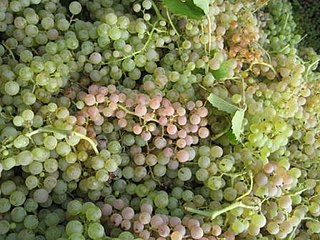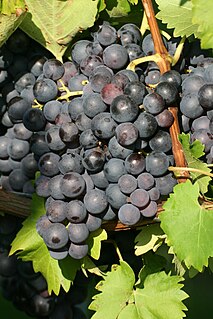
Garganega is a variety of white Italian wine grape widely grown in the Veneto region of North East Italy, particularly in the provinces of Verona and Vicenza. It is Italy's 6th most widely planted white grape. It forms the basis of Venetian white wine Soave and is also a major portion of the blend used to make Gambellara.

Sangiovese is a red Italian wine grape variety that derives its name from the Latin sanguis Jovis, "the blood of Jupiter". Though it is the grape of most of central Italy from Romagna down to Lazio, Campania and Sicily, outside Italy it is most famous as the only component of Brunello di Montalcino and Rosso di Montalcino and the main component of the blends Chianti, Carmignano, Vino Nobile di Montepulciano and Morellino di Scansano, although it can also be used to make varietal wines such as Sangiovese di Romagna and the modern "Super Tuscan" wines like Tignanello.

Trollinger, Schiava, or Vernatsch, is a red German/Italian wine grape variety that was likely first originally cultivated in the wine regions of South Tyrol and Trentino, but today is almost exclusively cultivated on steep, sunny locations in the Württemberg wine region of Baden-Württemberg. It is primarily known under the synonyms Trollinger in Germany, Vernatsch in South Tyrol and Schiava in other Italian regions. As a table grape the variety is sometimes known as Black Hamburg, which is commonly confused with the similar synonym for Black Muscat—a variety that is actually a cross of Trollinger and Muscat of Alexandria.

Marzemino is a red Italian wine grape variety that is primarily grown around Isera, south of Trentino. The wine is most noted for its mention in the opera Don Giovanni of Wolfgang Amadeus Mozart. The vine ripens late and is susceptible to many grape diseases including oidium. Wine produced from the grape has a characteristic dark tint and light plummy taste.

Montepulciano is a red Italian wine grape variety that is most noted for being the primary grape behind the DOCG wines Offida Rosso, Montepulciano d'Abruzzo, Montepulciano d'Abruzzo Colline Teramane, Rosso Conero and the DOC wine Rosso Piceno Superiore.

Tuscan wine is Italian wine from the Tuscany region. Located in central Italy along the Tyrrhenian coast, Tuscany is home to some of the world's most notable wine regions. Chianti, Brunello di Montalcino and Vino Nobile di Montepulciano are primarily made with Sangiovese grape whereas the Vernaccia grape is the basis of the white Vernaccia di San Gimignano. Tuscany is also known for the dessert wine Vin Santo, made from a variety of the region's grapes. Tuscany has forty-one Denominazioni di origine controllata (DOC) and eleven Denominazioni di Origine Controllata e Garantita (DOCG). In the 1970s a new class of wines known in the trade as "Super Tuscans" emerged. These wines were made outside DOC/DOCG regulations but were considered of high quality and commanded high prices. Many of these wines became cult wines. In the reformation of the Italian classification system many of the original Super Tuscans now qualify as DOC or DOCG wines but some producers still prefer the declassified rankings or to use the Indicazione Geografica Tipica (IGT) classification of Toscana. Tuscany has six sub-categories of IGT wines today.
Bombino bianco is a white Italian wine grape variety planted primarily along Italy's Adriatic coast line, most notably in Apulia. The vine is prone to high yields and often produces neutral flavor wines. The grape is known under many synonyms throughout Italy including Debit and Pagadebit, names which came from the grape's reputation for being a high yielding and reliable crop for vineyard owners to grow that would assure them that on each vintage they could pay off their debts.
Uva Tosca is a red Italian wine grape variety that is grown in the Emilia-Romagna region of east-central Italy where it is the only grape variety able to grow in the higher elevations of the Val Secchia area. Despite what its name may allude to, ampelographers have little evidence to believe that the grape originated in Tuscany or has any close genetic relationship with the notable Tuscan wine grape, Sangiovese, that is also known under the synonym of Uva Tosca. In 2010, DNA analysis suggested that Uva Tosca may be a natural crossing between the Alto-Adige wine grape Schiava Grossa and Crepallocchi.
Girò is a red Italian wine grape variety that is grown on Sardinia and is used mostly in the production of fortified wines in the Giro di Cagliari Denominazione di origine controllata (DOC). The grape was once widely planted throughout Sardinia but its plantings were decimated when the phylloxera epidemic hit the island at the end of the nineteenth century. At the turn of the 21st century there were 552 hectares of the grape planted throughout Italy, mostly in the Sardinian provinces of Cagliari and Oristano.

Petit Rouge is a red Italian wine grape variety that ampelographers believe is indigenous to the Valle d'Aosta region of northwest Italy. However, there is some confusion about whether Petit Rouge is the same variety as the red Swiss wine grape Rouge de Valais.

Pecorino is a white Italian wine grape variety that grows in the Marche, Abruzzo, Tuscany, Umbria and Lazio regions of Italy. Ampelographers believe that the grape is likely native to Marche, where the soil destined for this cultivation increases every year. This grape variety is used to produce the DOCG wines, like the Offida Pecorino DOCG, and the DOC wines, like the Falerio dei Colli Ascolani, the Colli Maceratesi and the Falerio dei Colli Ascolani.

Nosiola is a white Italian wine grape variety that is grown in the Trentino region north of Lake Garda in the Valle dei Laghi. Here it is used in varietal Denominazione di origine controllata (DOC) wines and as a blending component in wines such as Sorni Bianco from Trento. It is also used to produce a dessert wine in the Vin Santo style from grapes that have been allowed to dry out prior to fermentation.
Bracciola nera is a red Italian wine grape variety that is primarily found in the Liguria and Toscana wine regions of western Italy. The only Denominazione di origine controllata (DOC) that Bracciola nera plays a significant role is in the Colli di Luni DOC of Ligura where the grape is permitted to be blended with Sangiovese, Canaiolo, Pollera nera, Ciliegiolo, Vermentino nero and other varieties. A late-ripening variety, Bracciola nera usually contributes acidity to blends.
Colombana nera is a red Italian wine grape variety that is grown in Emilia-Romagna and Tuscany. Despite similarities in name, the grape did not get its name from nor is it grown in the San Colombano al Lambro region of Lombardy nor is it permitted in the Denominazione di origine controllata (DOC) wine of the same name. Rather, ampelographers believe that Colombana nera is named after the Abbey of San Colombano located in the commune of Bobbio in the Piacenza province of Emilia-Romagna where the grape has had a long history of cultivation.

Vermentino nero is a red Italian wine grape variety that is predominantly grown in province of Massa-Carrara in Tuscany. After World War II, the vine was almost lost to extinction until Podere Scurtarola, a producer from Massa, began replanting old vineyards with the grape. By 2000, there were 199 hectares of Vermentino nero growing in Italy with the grape authorized for production in the Denominazione di origine controllata (DOC) wines of Candia dei Colli Apuani and Colline Lucchesi.
Barbera bianca is a white Italian wine grape variety that is grown in the Piedmont wine region of northwest Italy. Despite being named Barbera bianca, the grape is not a color mutation of the red Piedmontese wine grape Barbera that is the third most widely planted grape variety in Italy. In fact, DNA analysis conducted in the early 21st century shows no genetic relationship at all between the two grape varieties.
Termarina rossa is a red Italian wine grape variety that is grown in the Emilia-Romagna region of northern Italy. The grape is unique among Vitis vinifera varieties in that it is naturally seedless. Historically Termarina rossa was grown in the provinces of Parma and Reggio Emilia for use in production of jams and saba, a sweet syrup, made from boiling the must but today it is used as a blending variety in some of Indicazione geografica tipica (IGT) wines of the area.
Alionza is a white Italian wine grape variety that is grown in the Emilia-Romagna region of north central Italy, where it has a long history of being used since the 14th century as both a table grape and blending grape for wine production. While sometimes confused with the Greek wine grape Sklava, DNA analysis in the early 21st century has suggested, instead, that Alionza may be closely related to the Tuscan wine grape Trebbiano.
Uvalino is a red Italian wine grape variety that is grown in the Piedmont wine region of northwest Italy. While the name uvalino means "small berries", ampelographers believe that the name may be derived from uvario which in the local Piedmontese dialect was used to denote wine grapes that were primarily minor blending varieties.
Biancone di Portoferraio is a white Italian wine grape variety that is grown almost exclusively on the island of Elba off the coast of Tuscany. Some ampelographers have speculated that the grape may have originated on the French island of Corsica where the grape shares a close genetic relationship with the Corsican wine grape Biancu Gentile.











